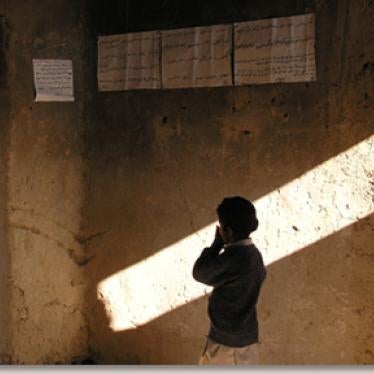(New York) - NATO forces operating under the mandate of the International Security Assistance Force to Afghanistan (ISAF) need to take greater precautions to protect civilians and establish a program to compensate Afghans who have lost family members, are injured or suffer property damage due to their actions, Human Rights Watch said today.
Recent ISAF operations have resulted in the deaths of dozens of civilians across the country. Although an ISAF statement expressed regrets about civilian casualties, it denied any wrongdoing.
“While NATO forces try to minimize harm to civilians, they obviously are not doing enough,” said Sam Zarifi, Human Rights Watch’s Asia research director. “NATO’s tactics are increasingly endangering the civilians that they are supposed to be protecting, and turning the local population against them.”
According to media reports, more than 60 civilians were killed this week in heavy fighting between NATO forces and insurgent forces in the Panjwai district of Kandahar province. NATO has admitted that at least 12 civilians were killed in NATO air and ground operations in Panjwai. Another two dozen were reportedly killed last week during clashes in Kandahar and neighboring Helmand province, during which NATO used heavy aerial bombardment.
On October 24 in southern Kunar province, NATO forces test-fired mortar rounds in a residential area that killed one girl and injured two other seven-year-old girls. And according to media reports, on July 31 in Helmand province, NATO aircraft fired upon a pickup truck, killing 13 members of a family, including nine children, who were trying to flee the fighting.
“Many Afghans looked forward to NATO’s deployment because they thought the force would protect Afghan civilians and help with reconstruction,” Zarifi said. “But NATO won’t win the trust of Afghans by showing disregard for civilian lives and property.”
NATO forces from Australia, Britain, Canada, Estonia, Denmark, the Netherlands, Romania and the United States extended ISAF’s coverage to southern Afghanistan six months ago. They are facing a growing insurgency comprised of resurgent Taliban and tribal militias and funded by a record-breaking opium trade. Despite numerous requests to NATO member states to increase their troop levels and provide additional logistical support, NATO fields only 18,000 troops in southern Afghanistan, an area nearly twice the size of Portugal.
NATO has relied extensively on “close air support” to attack insurgent positions. Although details are not publicized, an indication of the intensity of the fighting is that in June 2006, the United States Central Command reported that it had flown 340 air strikes in Afghanistan, more than twice the 160 carried out in Iraq.
NATO forces have reported using B-1 bombers, fighter jets such as F-16s, French-made Mirages, and British-made Harriers, as well as anti-tank aircraft like the A-10 “Warthog.”
Human Rights Watch expressed particular concern over repeated reports about the use of A-10s in civilian areas. Warthogs are primarily designed to serve as anti-tank attack planes, but also use high-speed machine guns and exploding shells to strafe infantry.
“NATO should reconsider the use of highly destructive but hard-to-target weaponry in areas where there is clear risk of considerable civilian casualties,” Zarifi said.
Under international humanitarian law, or the laws of war, armed forces must not target civilians or conduct attacks that cannot distinguish between combatants and civilians, or cause harm to civilians or civilian objects that is excessive in relation to the anticipated military advantage of the attack. Armed forces must take all feasible precautions to avoid harm to civilians and to verify that targets are military objectives. In cases where there is doubt as to whether a civilian object, such as a house, is being used for military purposes, attacking forces are obligated to assume it is not.
Taliban and other opposition forces have in the past placed civilians at risk by using populated areas to launch attacks on NATO and Afghan government forces. However, NATO still must take all feasible precautions when attacking areas in which civilians may be present, which include many areas where NATO has conducted military operations.
“NATO can’t simply state that it didn’t know civilians were present, or that they assumed all civilians had fled the area,” said Zarifi. “NATO must improve how it collects information, because even a cursory inquiry could have alerted NATO forces to the civilian presence in areas they’ve attacked.”
Afghan President Hamid Karzai has appointed a high-level committee to investigate the recent attacks. Human Rights Watch supports this effort but called on NATO to either conduct its own investigation or to allow independent, international experts to investigate. The investigation’s findings should be made public.
Human Rights Watch also joined a call by the US-based organization Campaign for Innocent Victims in Conflict (CIVIC) in calling for NATO to immediately create a program to provide monetary compensation for civilian death, injury or property damage resulting from military operations.
According to CIVIC, NATO secured a $4.5 million trust fund to assist Iraqi security forces. Human Rights Watch called on ISAF states to form a similar fund for Afghanistan. The United States already runs a compensation program in Afghanistan, which does not assign blame but provides condolence payments to families who suffered losses in U.S. operations. In addition, the US Congress has set aside $3 million for humanitarian aid to be administered by USAID and its partner, the International Office of Migration. Human Rights Watch called on other NATO members to follow suit.
“Compensating injured civilians is the right thing to do, and the smart thing to do,” Zarifi said. “This has been US policy, and there’s no reason it shouldn’t be NATO policy as well.”





